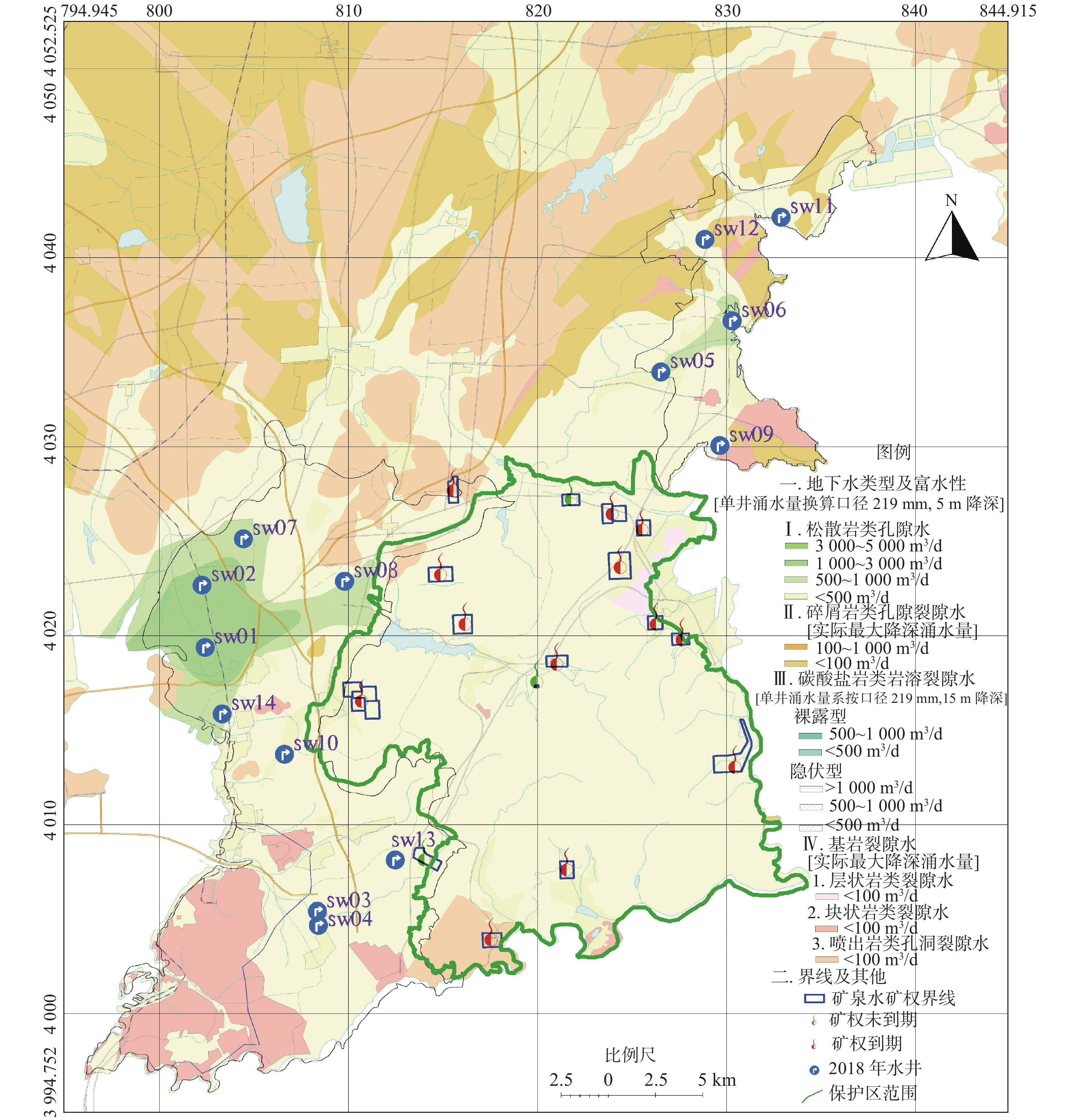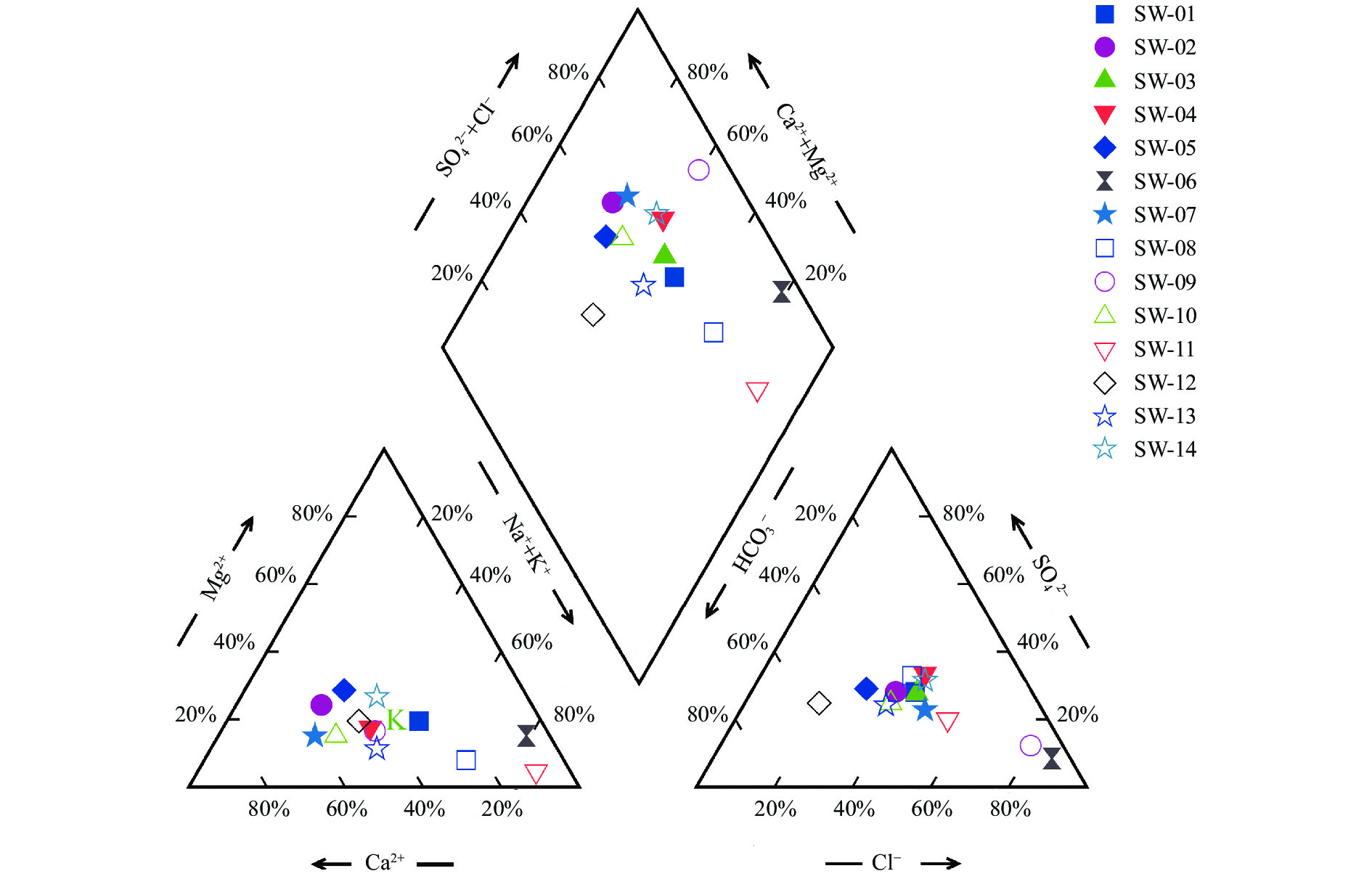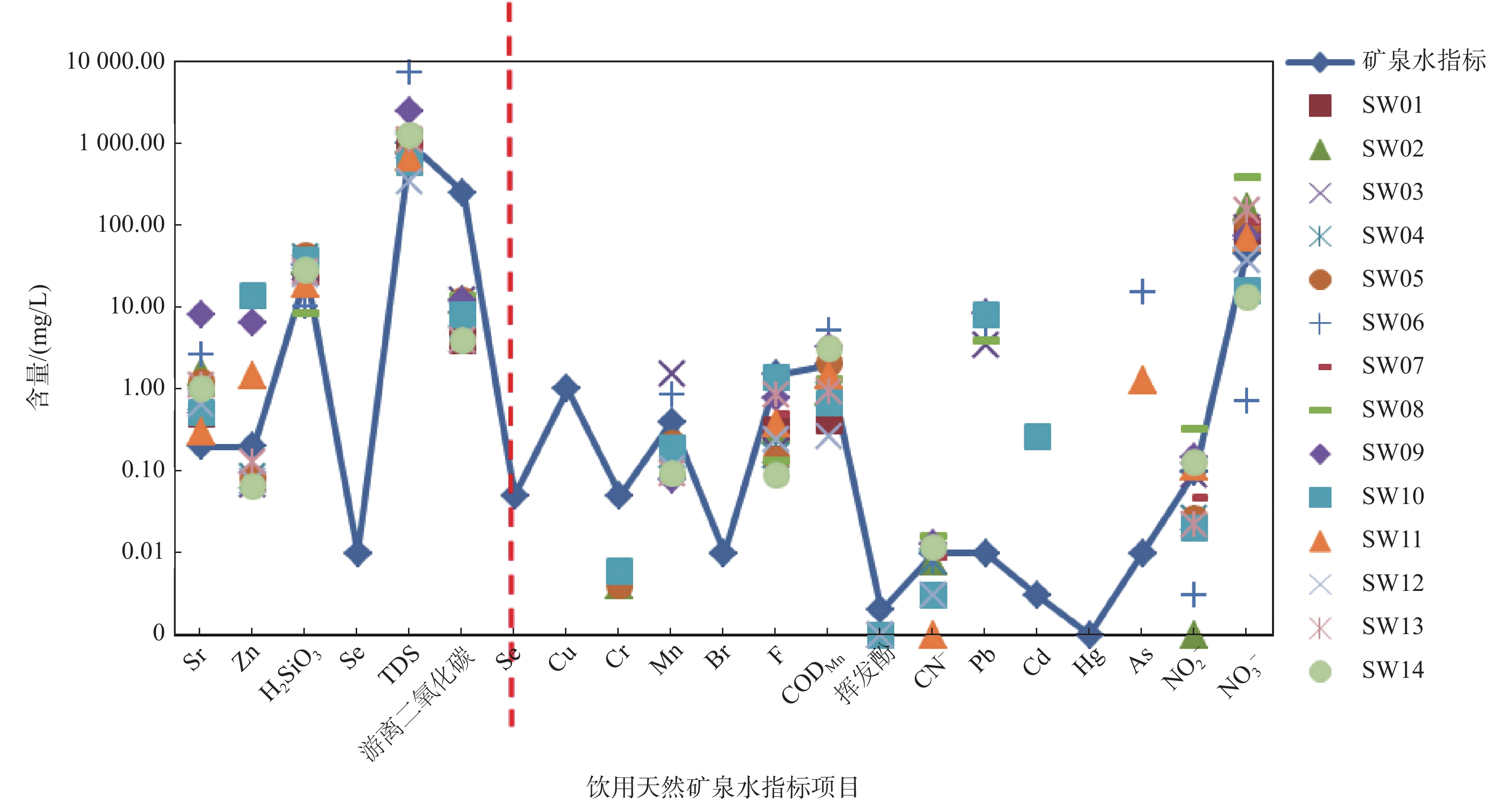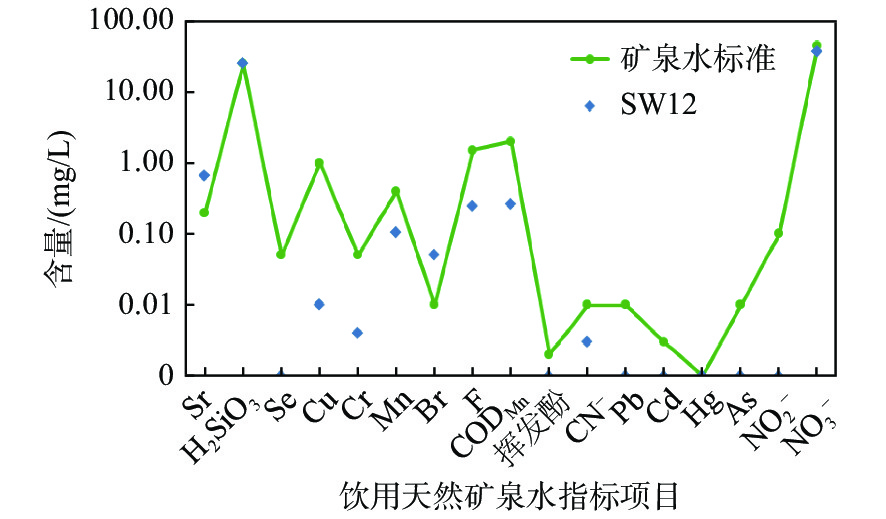HYDROCHEMICAL CHARACTERISTICS OF GROUNDWATER AND GENESIS OF MINERAL WATER AT LAOSHAN MOUNTAIN AND SURROUNDING AREAS, QINGDAO
-
摘要:
青岛崂山周边地区构造断裂及花岗岩风化壳发育,具有开发矿泉水的潜力。在崂山周边实施14口水文井,分析区域水文地质特征,发现主要水文地质问题集中在河流中下游人类活动较频繁的地区,工农业污染导致地下水硝酸根等超标,近海区域存在海(咸)水入侵现象。在蓝色硅谷区发现一处矿泉水后备选区,该点位于花岗岩风化壳内,水化学类型为HCO3·SO4-Ca·Na,微量元素锶含量为0.66 mg/L,偏硅酸含量为25.49 mg/L,均高于饮用天然矿泉水最低标准。矿泉水的形成主要与崂山地区地质环境特征及岩石矿物组成等因素密切相关,花岗岩中的二氧化硅和锶在长期水岩作用下融入水中,最终形成偏硅酸-锶复合型矿泉水。
Abstract:The Laoshan Mountain and its surrounding areas are rich in mineral water under the joint control of structural faults and weathering granite crust. In this paper, 14 hydrogeological wells are selected from the area surrounding the Laoshan Mountain for revealing the hydrogeological characteristics and concerned problems. The main hydrogeological problems are concentrated in the middle and lower reaches of rivers where human activities are frequent and active. Both industrial and agricultural pollution leads to the excess of nitrate in groundwater, in addition to saltwater intrusion occurred in the nearshore areas. A mineral water well located in the weathered crust of granite was discovered this time in the Lanseguigu District. The groundwater in the well belongs to the type of HCO3·SO4-Ca·Na. The contents of strontium (Sr) and metasilicic acid (H2SiO3) of the groundwater are 0.66 and 25.49 mg/L respectively, which are both higher than the standard content for drinking natural mineral water. The formation of the mineral water is closely related to the geological environment of the Laoshan area and mineral compositions of surrounding rocks. The strontium-metasilicic acid mineral water is formed by the dissolution of strontium and silica from granite into water by a long term water-rock interaction. This discovery is significant and may provide a new mineral water producing area in the Laoshan region of Qingdao.
-

-
图 4 SW01-SW14水样各类指标与饮用天然矿泉水指标(GB 8537—2018)[2]对比
Figure 4.
图 5 SW12水样各类指标与饮用天然矿泉水指标(GB 8537—2018)[2]对比
Figure 5.
表 1 SW01-SW14水质分析测试结果
Table 1. Water quality test results of samples SW01-SW14
/(mg/L) 测试项目 水样编号 SW01 SW02 SW03 SW04 SW05 SW06 SW07 SW08 SW09 SW10 SW11 SW12 SW13 SW14 K+ 0.56 1.24 2.01 2.00 2.95 95.52 0.81 2.65 6.74 1.23 2.37 0.84 0.74 16.97 Na+ 128.86 73.58 138.69 111.99 51.11 2120.79 69.45 279.49 374.84 57.73 181.81 35.33 145.62 141.40 Ca2+ 71.08 156.81 98.67 116.80 81.72 137.89 146.53 88.99 362.82 92.32 15.17 42.96 138.42 145.16 Mg2+ 27.25 43.70 36.83 28.64 31.54 222.85 23.01 18.24 84.10 15.54 5.30 10.97 21.19 61.38 Cl− 159.22 179.68 209.00 195.92 79.18 3926.83 189.53 182.44 1096.12 113.65 161.33 26.95 174.35 301.36 SO42− 144.92 188.52 182.76 214.12 108.44 514.12 127.09 212.94 236.94 103.03 81.61 47.47 160.00 299.56 HCO3− 194.30 291.45 246.11 194.30 194.30 342.60 207.25 226.68 181.35 194.30 129.53 136.01 323.83 304.40 Sr 0.5 1.57 0.70 0.76 1.22 2.57 0.91 0.91 7.96 0.51 0.30 0.66 1.11 1.04 H2SiO3 26.97 38.01 30.46 41.32 42.24 10.03 28.26 8.38 32.67 36.72 19.05 25.49 27.16 28.81 pH 7.25 7.70 7.75 7.60 7.50 7.55 7.90 7.05 7.05 7.70 8.35 8.00 7.50 7.30 NO2− <0.001 0.001 0.090 0.026 0.026 0.003 0.048 0.330 0.150 0.020 0.110 <0.001 0.022 0.130 NO3− 84.18 165.60 92.84 72.29 99.25 0.72 111.33 390.50 72.19 15.75 70.60 37.29 152.62 13.08 Zn <0.05 <0.05 0.07 0.09 0.08 <0.05 0.06 10.47 6.48 13.62 1.48 0.07 0.13 0.07 Se <1.0 <1.0 <1.0 <1.0 <1.0 <1.0 <1.0 <1.0 <1.0 <1.0 <1.0 <1.0 <1.0 <1.0 Mn <0.05 <0.05 1.51 0.15 0.22 0.86 <0.05 0.09 0.08 0.19 <0.05 0.11 0.10 0.09 CODMn 0.41 0.92 1.47 0.86 2.05 5.15 0.90 1.32 3.26 0.68 1.49 0.26 0.95 3.20 Pb <1.0 <1.0 3.454 <1.0 <1.0 6.253 <1.0 4.020 8.521 8.253 <1.0 <1.0 <1.0 <1.0 Cr <0.1 <0.1 <0.1 <0.1 <0.1 <0.1 <0.1 0.287 <0.1 0.267 <0.1 <0.1 <0.1 <0.1 As <1.0 <1.0 <1.0 <1.0 <1.0 15.31 <1.0 <1.0 <1.0 <1.0 1.29 <1.0 <1.0 <1.0 矿化度 810.37 1100.58 1007.09 936.05 648.49 7361.32 875.01 1401.94 2415.11 593.56 660.83 337.82 1117.63 1283.33 挥发酚 <0.001 <0.001 0.001 <0.001 <0.001 <0.001 <0.001 <0.001 <0.001 0.001 <0.001 0.001 <0.001 <0.001 氰化物 <0.001 0.008 0.008 0.008 0.003 0.010 0.009 0.016 0.013 0.003 0.001 0.003 <0.001 0.012 游离二氧化碳 4.00 11.99 11.99 7.99 11.99 4.20 4.00 13.99 11.99 7.99 0.00 4.00 4.00 4.00 注:指标选取参照《食品安全国家标准-饮用天然矿泉水GB 8537—2018》[2] 表 2 崂山花岗岩地区矿泉水化学成分及部分元素水迁移系数[6]
Table 2. Chemical composition of mineral water and water-migration coefficient of elements in the Laoshan Mountan granite area[6]
矿泉水 元素/(mg/L) pH K+ Na+ Ca2+ Mg2+ Cl− SO42− HCO3− Sr H2SiO3 构造裂隙水 0.65 21.17 35.64 7.49 43.16 14.79 92.3 0.25 43.13 7.46 浅层风化裂隙水 0.51 26.24 31.12 7.53 27.69 40.15 106.33 0.20 33.63 7.63 水迁移系数 0.104 2.27 22.88 10.71 − − − 10.02 0.150 -
[1] 范典高,段本春. 青岛即墨东北部地区基岩富水区新探[J]. 青岛海洋大学学报,1999,29(2):296-300.
[2] 中华人民共和国国家卫生健康委员会, 国家市场监督管理总局. GB 8537—2018食品安全国家标准 饮用天然矿泉水[S]. 北京: 中国标准出版社, 2018.
[3] 胡琴耀. 曲水矿泉水文地球化学特征与水资源评价[D]. 南昌: 东华理工大学, 2016.
[4] 安可士. 我国饮用天然矿泉水开发现状及主要问题[J]. 华北地质矿场杂志,1999(4):341-346.
[5] 危润初. 靖宇国家级自然保护区天然矿泉水形成机理研究[D]. 长春: 吉林大学, 2014.
[6] 赵广涛,李玉瑛,曹钦臣,等. 青岛西北地区矿泉水的水化学特征与形成机理[J]. 青岛海洋大学学报,1998,28(1):135-141.
[7] 孙岩. 青岛地区矿泉水的分类及分布规律[J]. 海洋地质与第四纪地质,1997,17(1):95-100.
[8] 孙嘉诗. 崂山饮用天然矿泉水[J]. 海洋地质与第四纪地质. 1996, 16(增刊.): 85-87.
[9] 赵永军,孙春燕,于典军. 崂山区饮用水生产行业现状及发展对策[J]. 山东水利,2004,7:22-23. doi: 10.3969/j.issn.1009-6159.2004.01.015
[10] 谭长伟. 变质岩区地下水富集规律的探讨[J]. 地下水, 1992, 14(2): 115-118.
[11] 宋健,唐方头,邓志辉,等. 沧口断裂黄岛断裂几何结构和活动特征[J]. 北京大学学报(自然科学版),2017,53:1020.
[12] 郭玉贵,金秉福,秦小光,等. 青岛沧口断裂的地质构造特征与第四纪活动性研究[J]. 震灾防御技术,2007,2(2):101-115. doi: 10.3969/j.issn.1673-5722.2007.02.001
[13] 栾光忠,任鲁川,段本春. 青岛及其邻区NE、NW向断裂的活动性研究[J]. 青岛海洋大学学报,1999,29(4):727-732.
[14] 高雅洁. 中国东部中生代板内花岗岩成因及构造意义——以崂山花岗岩为例[D]. 青岛: 中国科学院海洋研究所.
[15] 赵广涛,王德滋,曹钦臣,等. I-A型复合花岗岩体的热演化及其意义:以崂山花岗岩体为例[J]. 中国科学(D辑):地球科学,1998,28(4):296-302.
[16] 郭良, 相石宝, 徐兴永. 山东崂山花岗岩地质地貌特征[J]. 地质评论. 2007, 53(增刊): 138-143.
[17] 张保民. 青岛崂山花岗岩构造断裂系的含水性[J]. 山东地质. 1990, 6(1): 26-33.
[18] 赵广涛, 曹钦臣, 孙跃鹏. 崂山花岗岩地区含锶、偏硅酸矿泉水的形成机理[J] 青岛海洋大学学报, 1996, 26(2): 239-246.
[19] 张人权, 梁杏, 靳孟贵, 等. 水文地质学基础[M]. 北京: 地质出版社, 2011.
[20] 沈照理, 朱宛华, 钟左燊. 水文地球化学基础[M]. 北京: 地质出版社, 1993.
[21] 敬海霞,黄江华,葛旭,等. 安徽省舒城县柳抱泉天然饮用矿泉水水质特征及成因分析[J]. 地下水,2018,40(4):43-44,85. doi: 10.3969/j.issn.1004-1184.2018.04.012
[22] 谢厥琼. 广东省偏硅酸型饮用天然矿泉水水质特征、形成条件及水源地类型[J]. 广东地质,1998,13(3):39-43.
-




 下载:
下载:



